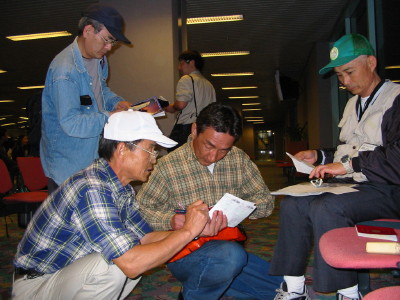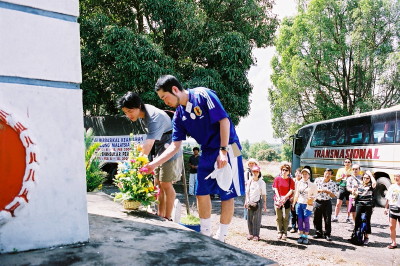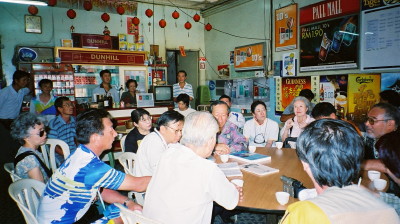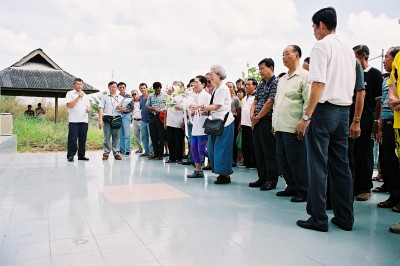February 8 (Sat), 2003
Narita and Kansai Airport (KIX) groups met at Changi Airport, Singapore, and walked to another deck for a flight to Kuala Lumpur. Clearing the immigration at KL International Airport (KLIA), changed to a domestic flight and arrived at Kota Bahru after 2300. Stayed in Hotel Perdana.

At Narita Airport before departure. We would not enter into Singapore country, but change to a flight for KL, Malaysia as transit passengers. At KLIA, would clear the immigration process, but further change to a domestic flight to Kota Bahru. FURUGORI Takeo (front left) checks ED cards with HOSHI Yutaka (center).

Arrived at Kota Bahru Airport in the midnight. Participants look a bit tired from long flights, but carrying their precious bicycles determinedly for cycling in coming days.
February 9 (Sun)
The first day at Kota Bahru starts with assembling bicycles in the hotel garden. A local school ex-headmaster joined the opening ceremony at the hotel conference room. He is to guide us all the way in Kota Bahru. The first event was a lunch party invited by the local Chinese Assembly Hall at a restaurant along Kelantan River. Kota Bahru War Museum was in a walking distance from the restaurant. After visiting a Chinese cenotaph in the suburb, went to Sabak seashore. The sand beach near the mouth of Kelantan River was where Takumi Detachment landed in the dawn of December 8, 1941.
In the evening when taking dinner at a neighboring restaurant to the hotel, officials of the Chinese Assembly Hall coincidentally came to the same room. Stayed in Hotel Perdana.

FURUGORI Takeo assembles his bicycle in the hotel garden under the morning sun shine.

After assembling bicycles, opening ceremony of self introductions and itinerary explanation at the hotel conference room. Mr. Lim He Hong, ex-headmaster of a local school joins as a guest. He is to guide us various places today.

Mr. Lim He Hong (left), interpreter and tour guide CC Yong (center), and chairperson KURACHI Hiroshi (right).

A short cycling in the city of Kota Bahru to the War Museum. With a limited traffic, the cycling was most comfortable. The top is always TAKI Hideki, and then MATSUNO Kikumi.

Kota Bahru is the town where IJA attacked earlier than Pearl Harbor by about 1 hour. Starting Hainan Island, southern part of main land China, Takumi Detachment, a part of the 25th Army convoy rushed into the defense line of British-Indian Army, and established a beachhead at a cost of 800 men. Being reported of this “success,” the main forces of the 25th Army lead by Lieutenant General Yamashita Tomoyuki forcibly landed on Singola (Songkhla today), Pattani, etc.

Pedaled for about 30km to the south from Kota Bahru and arrived at Bukit China or Chinese Cemetery. The youngest participants, SATO Ryosuke and YAMAMOTO Ryo laid a wreath to the Memorial of the War Heroes. When Mr. Lim was 2, his parents, brothers of 6 and 4, and a new born brother were killed by IJA. There was another row of cenotaphs with epitaphs, one of which being for his father.
IJA’s sweeping operation against Chinese resistance forces stretched as far as to Kota Bahru, the most northeastern part of the peninsula.

Sabak seashore is in the suburb of Kota Bahru, where Takumi Detachment landed. There is a remaining pillbox just under the sea, above which it is said that the water ruffles during low tides. IJA attacked here because of the airport, where 5MPPC landed previous day, and along which we cycled both ways this day. The immediate targets of IJA’s landing on other seashores of Thailand were also to acquire airports.
Expansionist policy of Japan since Meiji Restoration faced a historic turning point at Sabak, resulted in awkward failure, and left big adverse legacies.

Having been invited by Kota Bahru Chinese Assembly Hall for lunch, we met the same officials coincidentally at the nearby restaurant where we started own dinner. In due course of time, a very loud yelling of “Yam Seng” was heard from their table. That is shouted at joyous occasions like Luna New Year and on marriages, literally meaning “victory by drinking.” By and by the both groups disorderly mixed and socialized with repeated chorus of “Yam yam yam yam, Seng!”
February 10 (Mon)
Flying back to KLIA from Kota Bahru, visited Sendayan Cemetery in suburb of Seremban, Negeri Sembilan. Officials of Seremban Chinese Assembly Hall welcomed us. Sad news reached us here from Tokyo, that the spouse of YUNOKI Yasuko had passed in home. YUNOKI and MATSUNO Kikumi immediately returned home.
Next place of visit is Malacca. Officials of Malacca Chinese Assembly Hall met us, and invited for dinner. The newly learned “Yam Seng” was common and very useful here too. Stayed in City Bayview Hotel.

Departing Kota Bahru in the morning, flew back to KLIA. Without visiting KL this time, we would go as far as to Singapore. The first visit was Sendayan Cemetery, suburb of Seremban, Negeri Sembilan.
An astonishing report came from Japan telling that Mr. YUNOKI Yukio had passed in home. He was to join us at Singapore. Yasuko and accompanying MATSUNO Kikumi decided to return today. The two women laid a wreath to a brand new cenotaph for all the victims in Negeri Sembilan. Officials of Seremban Chinese Assembly Hall, who we have met in 3 and 4MPPC, received us, and kindly sent YUNOKI et.al. to Seremban taxi stand for KLIA.

Moved to Malacca, an old city. Officials of Malacca Chinese Assembly Hall, our old acquaintances, welcomed MPPC. In a foot of Bukit China, there is a cenotaph that memorizes hundreds of Chinese victims killed by IJA. The words written on the cenotaph reads “Your loyalty (to the country) is a model to others,” a favorite phrase that Chiang Kai-shek, Kuomintang president, was fond of.

Another banquet hosted by the local Chinese Assembly Hall. JMN, JP Mr. Sim Mow Yu, former president of MCAH, addressed a welcome speech by citing a teaching of Kong Zi, to which KURACHI Hiroshi made a speech in response by mentioning another part of the Analects. The decoration of the room is for the Luna New Year.

Officials of MCAH, Datuk Tee Eng Tuang (center), on his right is Mr. Sim Mow Yu (92), and secretary Mr. Chang Ya Shang (extreme right).
February 11 (Tue)
Visited by bicycles and the bus to inland Kuala Pillah, Sungai Lui, and Gemas (Negeri Sembilan), Gemas Bahru, as well as Batu Pahat (Johor) along the Malacca Strait.
Stayed in Garden Hotel, Batu Pahat.

Detoured visiting inland towns, though it is only 100km if you go directly from Malacca to Batu Pahat along the West Coast (Malacca Strait). In Kuala Pillah, saw a place where IJA troops stayed, and its comfort house. Then proceeded further to inland Sungai Lui. Both sides of the road are covered with rubber trees and palm as seen in the photo. Though mass products made of palm oil such as vegetable oil and shampoo are advertised as environment friendly, our concern is what would happen to ecosystems with the recent large plantation of palm surpassing rubber and transforming virgin forests into monoculture.

At Sungai Lui, near Pahang, the former headmaster Mr. Lim Kim Huat (center) waited us and greeted saying that he appreciates MPPC that came all the long way. The local legend says that one day an IJA unit came here by train, ordered 368 local people mostly of women and children to gather, confined them in 11 houses, and killed by bayoneting or burning down, in allegation that there were anti-Japanese groups in the village. The witness is reliable because it was made by a Malay headmaster, who in general is not in harmonious relation with Chinese people (based on “Massacre of Chinese” written by Prof. HAYASHI Hirofumi). We heard that for renewal of the cenotaph, Prof. TAKASHIMA Nobuyoshi and others also contributed.

Went by bus to Gemas Bahru, Johor, after dropping in Gemas Station where a fierce battle took place. There is a small cenotaph in the side of Route #1. About 200-300 Chinese people were killed by IJA during 3 years and 8 months of Japanese occupation. Mr. Lee Han Chan, village headman, met us at a neighboring grocery shop. He frankly reproached us by saying that MPPC has yet to realize any visible result in Japan.
February 12 (Wed)
Revisited Senggarang via Batu Pahat. Mr. Kwan Yee Chain and other people who we have met at 4MPPC waited for us. Then moved to Kota Tinggi, an inland town for the first time. We were much obliged by being welcomed by many people. Further proceeding to Johor Bahru, stayed in Eden Garden Hotel, from where Singapore is seen across the strait.

Forwarded southward from Batu Pahat to Senggarang along Route #5. In the upstream of the River Semberong that flows by Batu Pahat, there used to be an iron ore that Ishihara Sangyo Kaisha mined. There remains an old apartment house where a prominent poet KANEKO Mitsuharu once stayed.
Though we retired from cycling in 4MPPC on the way due to heavy rain, this time we could comfortably cycle all the way to Senggarang with fine weather. KAITO Tomoi in the left, followed by YAMAMOTO Ryo.

Arrived at Kwang Fu Cemetery in the suburb. Mr. Kwan Yee Chain, president of Senggarang Chinese Assembly Hall (center with aloha shirt) and more than 10 gentlemen welcomed us. Laying a wreath there, moved to the office in the town, where we were served with handmade lunch. Then Mr. Liu Kim Tien witnessed with tears about his childhood story; his father was one day seized by IJA to somewhere and never returned since.

Kota Tinggi is an inland town of Johor. Though the first time to visit, over 40 people waited us at the cenotaph. YAMAGUCHI Hiroko (right) and SATO Kaori (left) laid a wreath. Several local folks witnessed about their family members being killed by IJA. Interpreter was Mr. Ken Lim, a young businessman who visits Japan for business occasionally, according to him.
February 13 (Thu)
In the morning, cycled to the cenotaph of Johor in the city of Johor Bahru (JB). Vice president of Johor Chinese Assembly Hall criticized Japan in his address. Next event was to fly lanterns called Kong Ming Deng as hot-air balloons. It is a Chinese tradition in Luna New Year to wish something; prominent calligraphers wrote “peace” on them before flying.
Then crossed the border to Singapore by bicycles. Taking lunch at Changi Village, pedaled to the city under a refreshing rows of trees in the east coast. Stayed in favorite Peninsula Hotel.


By cycling on Route #3 in JB City for a while, reached a big Johor Cenotaph along Jalan Kubun Teh. The epitaph here says that around 2000 Chinese people are buried here. They were killed by IJA because they had contributed money and sent materials to main land China. Mr. Lai Yi Cheng, vice president of Johor Chinese Assembly Hall criticized never-reflecting-the-past Japanese government with grim looking face.
【left】Media staff interviewed us; SATO Ryosuke is surrounded by them.
【right】YAMAMOTO Ryo is also being interviewed.

After addresses from the both sides is a Luna New Year event called Kong Ming Deng. First, 4 prominent local calligraphers wrote “peace” with brushes on 2 lanterns. By putting fire on the bottom plates, they began soaring into sky as hot-air balloons. The insecure Chinese tradition may be equivalent to our floating lanterns or bamboo-leaf boats on the water wishing something. Zhuge Konming of Sanguo Zhi (Three Kingdoms History) is said to utilize this as a communication tool. The balloon quickly flew as high as hundreds of meters and disappeared from our sights.

Completing planned visits in Malaysia at JB, entered into Singapore by crossing the Causeway Bridge on Johor Strait. This is what you can never experience in Japan. YOSHINO Nobuji (left) and IIDA Hiroshi on immediate left. On the right hand are one track Malay Railway and water supply pipe from Malaysia to Singapore.

In Singapore, went directly to Changi Village in the backyard of Changi Airport by the same bus on a toll way. Here is a good secret place of open stalls for lunch, where airport staffs like pilots also swarm. After lunch, saw a cenotaph for Chinese victims at nearby Changi Beach, pedaled to Peninsula Hotel under refreshing rows of trees side by side with the run ways. Small islands seen on the left hand are mostly of Indonesia. Being the last run by bicycles today, dismantled the gears and packed in bags in a large stadium garden.
February 14 (Fri)
Touring all the day by bus seeing the war related remnants, 4-5 places though. As big as Amami Oshima (710 sq km with population of 5 million), and places to visit scattered all over the island, we could saw limited ones in central part. Stayed in Peninsula Hotel.

There was the Changi Prison near Changi Airport in which large number of Allied prisoners of war and civilian internees were detained during the wartime. The Changi Prison Museum was recently renewed near the old one. A replica of a church is part of it, where families of ex-POW visit and leave message cards on the walls.
From left; KURACHI Hiroshi, NADA Akiko, JIDAISHO Reiko, and SHISHIKURA Yoshie.

MacRitchie Reservoir. There is a tomb of Major General Lim Bo Seng, a pro-Kuomintang anti-Japanese figure (the location might be the place where once Shonan Jinja (shrine) was erected and destroyed right after the war, but not yet confirmed). He was arrested at Ipoh by IJA, and died in the suburban Batu Gajah Prison. His corpse was moved here and reburied after the war.

After seeing the renewed Sun Yat Seng Nanyan Villa and Bukit Batok Memorial (Refurbished by the government in 1995. This was the place where there were Shonan Memorial for the IJA dead, and a cross for Allied dead. Fierce battle took place here), went to the place where Ford Factory was, but could not enter the site being surrounded by wire net, through which a sign board was seen. At a small conference room here, British commander Lieutenant General Percival surrendered to Japanese Lieutenant General YAMASHITA Tomoyuki. (Currently, a gorgeous museum called Old Ford Factory is opened)

Alexandra Hospital was one of the largest Army hospitals that UK had overseas in the prewar time. This is the place where on February 14, 1942, the 18th Division, IJA killed 50 patients and medical staff, as they were fired from the hospital, and killed another 150 next day. In the garden is a plaque telling the tragedy. The incident being widely described/discussed in documents, nobody was punished at the war tribunal, the reason being said that UK prosecution was slipshod.
February 15 (Sat)
Formally participated in the annual ritual in front of the War Memorial Tower for the first time, a 30 minute long but solemn proceeding. Media covered our participation intensely.
Wrap up meeting at the hotel conference room from 4pm, followed by the last supper, and took night flights to Narita and KIX.

36th War Memorial Service is held in front of the War Memorial Tower from 9am. This is the day when UK surrendered to Japan in 1942. The whole itinerary of 5MPPC is designed around this day. The place is 5 minutes walk from the hotel. The ceremony is organized not by the government, but by Singapore Chinese Chamber of Commerce and Industry. The government representative is the main guest, while about 10 relevant ambassadors including from Japan are the honorable guests. MPPC members were allowed to sit under the tent, sort of infield seats, with “company attire, but ties and suits are unnecessary” in line with the dress code of SCCCI. Mr. Wu Zhi Chao, KL was present. His elder brother was killed in Singapore, while Mr. Wu barely escaped to KL with his life at the time of Sook Chin in 1942.
In the side of the official ceremony was a private alter, where citizens offered incense sticks and flowers and prayed with clasped hands.

Took lunch at a buffet style restaurant near the renewed big Marlion, 10 minutes away from the War Memorial, followed by a free time for a while. JIDAISHO Reiko (left) and NADA Akiko. From 4pm, a wrap up meeting in the hotel conference room. At 9pm, forwarded to the airport by the bus and departed by midnight flights.